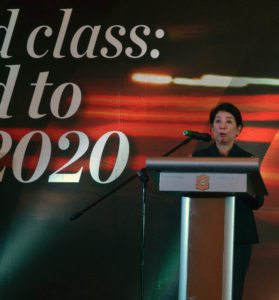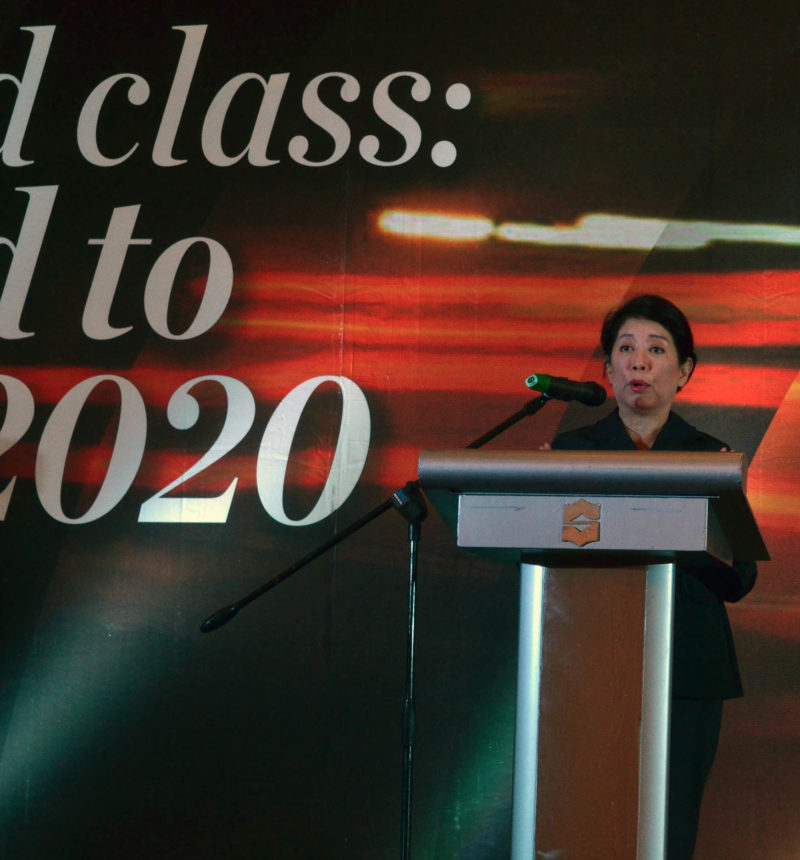
The Philippines must roll out a long-term plan and massive structural reform for both public and private sectors in order to achieve inclusive growth as tighter regional integration looms, according to Doris Magsaysay-Ho, president and chief executive officer of A. Magsaysay, Inc.
“We are the luckiest country in the world. We grew 6% without a plan. Imagine if we have a plan,” Ho told participants of the 2016 Supply Chain Management Association of the Philippines (SCMAP) Supply Chain Conference on September 14.
The country’s growth and prosperity, however, “have not trickled down to majority of the people at the bottom of the pyramid, creating a widening gap between the rich and the poor,” Ho said.
She noted how the country’s poor quality of services and lack of infrastructure are “giving each of us great stress and frustration in our own personal lives” as well as constraining businesses delivering “of products and services.”
“So business as usual is no longer an option,” Ho said.
Instead, as regional integration intensifies, the country must have an “audacious vision and a massive structural reform for both the public and private sectors.”
“But we must realize that APEC (Asia-Pacific Economic Cooperation) and ASEAN (Association of Southeast Asian Nations) regional economic integration benefits the country most when we deliberately seize opportunities and enter markets that are beyond ours,” Ho pointed out.
Business growth agenda
“So I believe the first part of our nation’s vision must be to develop a clear national strategy that identifies specific growth sectors in manufacturing, services, agriculture, where jobs could be generated, where we have a distinct competitive advantage, and a unique selling composition that expands beyond domestic markets.”
The strategic plan, the shipping executive said, will be built upon the President’s socioeconomic agenda and serve as the rallying point for businesses, government, and civil society to work together.
As an example, Ho said New Zealand, which has a small population but a large capacity for production, has successfully branded its products and services.
“When you think about New Zealand, you don’t just buy wine, you buy New Zealand wine. You eat New Zealand lamb chops. We buy New Zealand dairy products. We watch The Lord of the Rings and you know it’s from New Zealand,” Ho noted.
She added that New Zealand was part of the P4 (Trans-Pacific Strategic Economic Partnership), which started the Trans-Pacific Partnership. P4 also includes Singapore, Brunei, and Chile, which she noted are small economies that know that in order to grow, they should get their products to other markets.
However, all the planning would mean nothing if not “meticulously implemented” and with no ecosystem to support it.
Ho pointed out that the country subscribes to a “kanya-kanya development,” where “everyone (is out) for himself,” as seen in private sector development activities that don’t connect.
“This kanya-kanya mentality is our biggest challenge, for anybody who’s trying to solve the problems that we face in the supply chain,” Ho said.
“We have farmers with two to five hectares without any support system, without any plan to make them act as a whole, no efforts to create cooperatives that work; thus, each of us in the supply chain, especially those of us in transport and shipping, are faced with the challenge on how to serve the tingi (retail) economy, without these economies of scale that are needed to really have meaningful change in cost, compounded by the lack of roads and the transport network needed.”
Clustering to achieve scale
Ho said the shipping sector is also promoting the idea of creating economies of scale in trade so as to cut costs in logistics and transport.
She said the country has to “create a new mindset of clustering” to be able to create economies of scale.
Ho explained the country is competing with economies that have clusters, like Kaohsiung in Taiwan which has a manufacturing cluster with a big port nearby.
Another is Vietnam, which has a plan to build up its agriculture sector to create more volumes and to get out of the feeder economy.
“Shipping follows trade, and economies of scale brought about by clustered development all over the country will allow bigger ships (to come in), will create balance between north- and south-bound cargo as well as import and export trade,” Ho explained.
The Philippines should “likewise identify large cluster areas around strategically located ports zoned as production and processing areas regardless of who owns the land.”
She noted, however, that “more complex zoning would need political will.”
Inclusive growth that incorporates small and medium-sized enterprises is best achieved with clustered development, Ho added.
Moreover, she said this needs support such as foreign direct investors extending incentives to their local subcontractors so the latter can also serve other global markets directly.
Besides, clustering can be the first step while the current administration contemplates a federal form of government.
When each province has its own strategic plan, this “will result in greater welfare to provinces” and lead to the decongestion of Manila, Ho noted.
While the private sector attempts to break away from the silo mentality, she said the government must do the same “so the specific goals can be seamlessly achieved.”
She noted Thailand early on has set its vision for its food industry, with the government certifying all food establishments and helping farmers produce the products needed to support them.
Now Thailand’s goal is to set up 500 restaurants in other countries. Ho said loving Thai food entails trying to learn the country’s culture; this has so far translated to an average of 18 million tourists in that country each year, she noted.
Infrastructure development must also be a part of the long-term plan. Ho quoted a former mayor of Bogota in Colombia who said that a true developed society “is not a place where the poor have cars. It’s where the rich use public transportation.”
And “in order to make massive shifts of thinking,” Ho said there is a need to strengthen government.
In order to achieve long-term thinking in the government, some government positions must not be appointed and should have longer tenures, she pointed out.
“For example, the heads of the MMDA (Metropolitan Manila Development Authority) should not be appointed, nor the PPA (Philippine Ports Authority) head because these (agencies) these need long-term thinking solution.
“There is a lot of noise around but we must not become distracted, we should instead fill this noise with a new kind of noise—that of an ambitious country, that of an ambitious people, that of an ambitious government sector that truly has a plan for the future.” – Text and photo by Roumina Pablo





